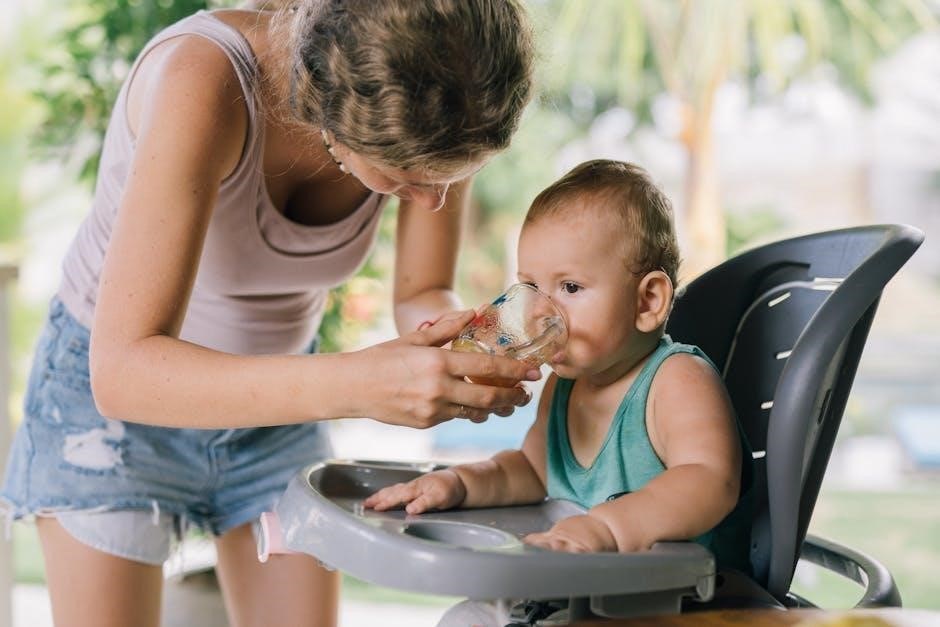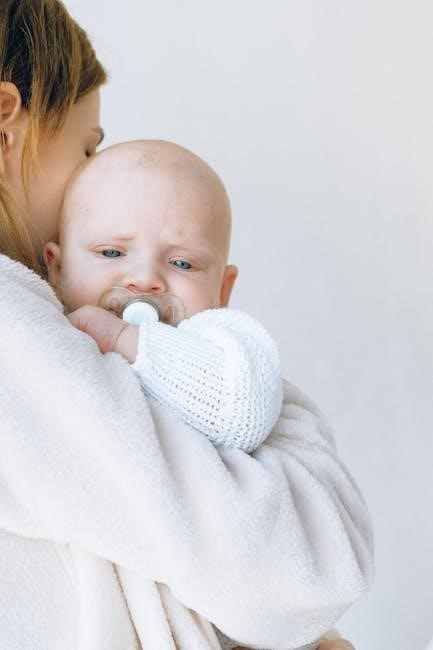love to dream swaddle temperature guide

The Love to Dream Swaddle Temperature Guide offers a comprehensive approach to ensuring your baby’s comfort and safety during sleep. It provides essential insights into maintaining optimal temperatures, understanding TOG ratings, and selecting appropriate clothing for swaddling. This guide helps parents create a safe sleep environment, balancing warmth and breathability to promote healthy sleep habits. By following the recommendations, caregivers can avoid overheating or underheating, ensuring their baby sleeps soundly and comfortably year-round.
What is the Love to Dream Swaddle?
The Love to Dream Swaddle is a premium sleep solution designed to promote safe and comfortable sleep for babies. It is crafted from soft, breathable materials that regulate body temperature, preventing overheating. The swaddle’s ergonomic design allows for natural movement, ensuring your baby’s arms and legs are in a healthy position. It is ideal for swaddling newborns and older babies, offering a cozy yet flexible fit; The Love to Dream Swaddle is available in various styles and sizes, catering to different seasons and room temperatures. Its machine-washable fabric makes it practical for daily use. Parents appreciate its ease of use and how it helps create a soothing sleep environment, fostering better sleep quality for their little ones.
Why Temperature Control Matters for Infant Sleep
Temperature control is crucial for infant sleep as it directly impacts comfort, safety, and overall well-being. Overheating can increase the risk of SIDS (Sudden Infant Death Syndrome), while being too cold may disrupt sleep and cause distress. Maintaining an optimal temperature ensures your baby sleeps soundly and stays healthy. Signs of overheating include sweating, flushed skin, or rapid breathing, while underheating may cause shivering or pale skin. The Love to Dream Swaddle is designed to regulate body heat, offering breathability and warmth. By monitoring room temperature and dressing your baby appropriately, you create a safe sleep environment that promotes better rest and development. Proper temperature control helps prevent discomfort, ensuring your baby feels secure and relaxed during sleep.

Understanding TOG Ratings
TOG (Thermal Overall Grade) measures fabric warmth, helping parents choose appropriate garments for their baby’s sleep. Higher TOG ratings suit colder environments, while lower ratings are better for warmer settings.
What is TOG (Thermal Overall Grade)?
TOG (Thermal Overall Grade) is an industry-recognized measurement that indicates the warmth and thermal resistance of fabrics used in sleepwear and bedding. It helps parents determine the suitability of garments for different room temperatures. A higher TOG rating means the fabric provides more warmth, while a lower rating is better for warmer environments. For example, a 0.5 TOG is ideal for lightweight materials, while a 3.5 TOG is designed for colder conditions. Understanding TOG levels is crucial for dressing your baby appropriately, ensuring they are neither too hot nor too cold. This guide helps parents make informed decisions to create a safe and comfortable sleep environment for their baby, especially when using the Love to Dream Swaddle.
How TOG Ratings Relate to the Love to Dream Swaddle
TOG ratings are directly tied to the Love to Dream Swaddle, helping parents choose the right product for their baby’s sleep environment. The Love to Dream Swaddle is designed to work seamlessly with TOG guidelines, offering options like the All Seasons Swaddle Up, which adapts to various temperatures by adjusting layers. For example, in cooler rooms (below 64°F), a higher TOG-rated swaddle is recommended, while warmer rooms (above 75°F) may require a lower TOG. The swaddle’s breathable, ergonomic design ensures comfort and safety, aligning with TOG standards to prevent overheating or underheating. By matching the swaddle’s TOG rating to the room temperature, parents can create a balanced and secure sleep setting for their baby. This ensures optimal comfort and promotes healthy sleep habits from the start.

Ideal Room Temperature for Swaddling
The ideal room temperature for swaddling is between 68-72°F, ensuring your baby’s comfort and safety. This range prevents overheating and maintains a cozy sleep environment.

Recommended Room Temperature Range (68-72°F)
Maintaining a room temperature between 68-72°F is crucial for your baby’s comfort and safety while swaddled. This range ensures the environment is neither too hot nor too cold, promoting undisturbed sleep. According to the Love to Dream Swaddle Temperature Guide, this range aligns with the natural thermoneutral zone for infants, where their bodies can regulate temperature effectively without excess strain. A temperature within this range helps prevent overheating, which is a key factor in reducing the risk of SIDS (Sudden Infant Death Syndrome). Additionally, it ensures your baby doesn’t feel chilly, which can disrupt sleep patterns. By keeping the room within this recommended range, you create an optimal sleep environment that supports your baby’s overall well-being and sleep quality.
How to Measure and Maintain Optimal Room Temperature
To ensure your baby’s room stays within the recommended temperature range of 68-72°F, start by using a reliable digital thermometer for accurate readings. Place it away from direct sunlight and drafts to get a consistent measurement. Check the temperature regularly, especially during extreme weather, to maintain stability. In summer, use light curtains or blinds to keep the room cool, while in winter, consider a heater but avoid overheating. Dress your baby appropriately, adding layers in cooler temperatures and using lighter clothing in warmer conditions. Understanding TOG ratings can help you choose the right clothing for different seasons. Adjust clothing based on the room temperature to prevent overheating or underheating. Maintain a stable temperature to promote undisturbed sleep and adjust as needed based on your baby’s comfort and seasonal changes.

Dressing Your Baby for Swaddling
Dress your baby in layers to ensure comfort and breathability. Use light, breathable fabrics for warmer temperatures and add layers for cooler environments, avoiding overheating.
Layering Clothing Based on TOG Ratings


Layering your baby’s clothing according to TOG ratings ensures optimal comfort and prevents overheating. Start with a lightweight, breathable base layer like a cotton onesie. Add a mid-layer such as a sleepsuit or footed romper for cooler rooms. Finally, use the Love to Dream Swaddle with the appropriate TOG rating based on your room temperature. For example, in a 68-72°F room, a 1.0 TOG swaddle is ideal. Adjust layers seasonally, adding more for colder months and using lighter options in warmer weather. Always check your baby’s comfort by feeling their chest or back, ensuring they’re neither too hot nor too cold.
Examples of Appropriate Clothing for Different TOG Levels
For a 0.5 TOG rating, dress your baby in a lightweight onesie or just a diaper under the swaddle. At 1.0 TOG, a cotton onesie paired with the Love to Dream Swaddle is ideal. For a 2.0 TOG, layer a footed romper or sleepsuit beneath the swaddle. In colder climates or for a 2.5 TOG, consider a thermal onesie with a lightweight sleeper. Always ensure the swaddle matches the room temperature and your baby’s comfort. Adjust layers according to seasonal changes to maintain the perfect balance of warmth and breathability.
How to Check Your Baby’s Temperature
The best way to monitor your baby’s comfort is by feeling their chest or back. Avoid checking hands and feet, as they tend to be cooler. Look for signs of overheating, such as sweating or flushed skin, and adjust clothing layers accordingly to ensure a safe sleep environment.

The Best Way to Monitor Your Baby’s Comfort
Monitoring your baby’s comfort is crucial for ensuring their safety and well-being during sleep. The best way to check your baby’s temperature is by gently feeling their chest or back, as these areas provide an accurate gauge of their body heat. Avoid relying on their hands or feet, as they tend to feel cooler naturally. Look for signs of overheating, such as sweating, flushed skin, or restless movements, and adjust their clothing or environment accordingly. If your baby feels too cold, they may shiver or have cool extremities. Use these cues to maintain a balanced and comfortable sleep environment. Regular checks ensure your baby stays cozy and secure, promoting healthy sleep habits and peace of mind for parents.
Signs of Overheating or Underheating
Recognizing signs of overheating or underheating is vital for maintaining your baby’s comfort and safety. Overheating can be identified by excessive sweating, flushed skin, or restless movements, while underheating may cause shivering or cool extremities. If your baby feels too hot, remove layers or adjust the room temperature. For underheating, add a lightweight layer or increase the room warmth. Regularly monitor your baby’s comfort to ensure their sleep environment remains balanced and safe. These observations help prevent potential discomfort and promote healthy sleep patterns, giving parents peace of mind while caring for their little ones.

Troubleshooting Common Temperature-Related Issues
Address overheating by removing layers or lowering the room temperature. For underheating, add lightweight clothing or increase warmth. Adjust accordingly to ensure comfort and safety.

What to Do if Your Baby Feels Too Hot
If your baby feels too hot, check the room temperature and adjust it to within the recommended range of 68-72°F. Remove any excess layers and ensure the swaddle is not too tight, as this can trap heat. Consider using a swaddle with a lower TOG rating or switching to a lighter fabric. Monitor your baby’s comfort by gently feeling their chest or back, as these areas are better indicators of their core temperature than hands or feet. If your baby is still uncomfortable, you may need to transition to a sleep sack or lighter clothing. Always prioritize breathable materials and avoid over-dressing to prevent overheating. Adjusting these factors can help restore your baby’s comfort and ensure a safe sleep environment.
What to Do if Your Baby Feels Too Cold
If your baby feels too cold, start by checking the room temperature and ensuring it’s within the recommended range of 68-72°F. Add a warmer layer of clothing, such as a thicker onesie or sleeper, appropriate for the current TOG rating. Use a swaddle with a higher TOG rating to provide extra warmth. Ensure the swaddle fits properly and isn’t too tight, as this can restrict movement and affect comfort. Monitor your baby’s temperature by gently feeling their chest or back; if they feel cool or are shivering, they may need more layers. Consider using a sleep sack with a higher TOG for colder environments. Seasonally, opt for heavier fabrics in colder months and lighter ones in warmer months. Always use breathable materials to prevent overheating while keeping your baby warm and comfortable.
Seasonal Considerations for Swaddling
Seasonal changes require adjustments to your baby’s swaddling setup to ensure comfort and safety. In warmer months, opt for lightweight, breathable fabrics and lower TOG-rated swaddles to prevent overheating. During colder months, use thicker, warmer layers and higher TOG-rated swaddles to maintain coziness. Layering clothing appropriately based on the season is key; for example, a lightweight onesie in summer and a heavier sleeper in winter. Monitor room temperature and adjust layers accordingly to keep your baby comfortable. Be mindful of humidity levels, as they can affect how your baby feels. Always prioritize breathable materials to avoid overheating, regardless of the season. By adapting your approach, you can ensure your baby sleeps soundly and safely all year round.